Episode #398: Building Coherence Between Math Coaches, Principals, and Teachers
LISTEN NOW HERE…
WATCH NOW…
This episode is a debrief of the article Coaching for Coherence: How Instructional Coaches Lead Change in the Evaluation Era by Woulfin & Rigby (2017). We explore how math coaches can lead meaningful instructional improvement when their role is clearly defined and aligned with both evaluation systems and the goals of ambitious instruction.
You’ll hear our reflections on three core functions of math coaches—developing shared understandings, modeling instructional practices, and brokering two-way communication between classrooms and leadership. We also unpack common challenges, including the risk of coaches being perceived as evaluators, and offer recommendations to create a safe, impactful math coaching culture that builds trust and coherence across the system.
In this episode, you’ll discover:
- Why math coaching needs to be framed as developmental, not evaluative
- The three essential roles math coaches play in a coherent instructional system
- How content-specific coaching aligned to standards can drive improvement
- Why district infrastructure and principal leadership matter for coaching success
- How to protect trust and clarity in the math coach–teacher relationship
Attention District Math Leaders:
Not sure what matters most when designing math improvement plans? Take this assessment and get a free customized report: https://makemathmoments.com/grow/
Ready to design your math improvement plan with guidance, support and using structure? Learn how to follow our 4 stage process. https://growyourmathprogram.com
Looking to supplement your curriculum with problem based lessons and units? Make Math Moments Problem Based Lessons & Units
Be Our Next Podcast Guest!
Join as an Interview Guest or on a Mentoring Moment Call
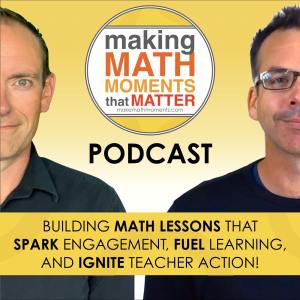
Apply to be a Featured Interview Guest
Book a Mentoring Moment Coaching Call
Are You an Official Math Moment Maker?
FULL TRANSCRIPT
Jon Orr: We’re going to debrief an article that both Yvette and I have read over the last little bit, which is called Coaching for Coherence, How Instructional Coaches Lead Change in the Evaluation Era. This is by Sarah Wolfman and Jessica Rigby. The article was published in 2017. It is all about coaching and being, know, coaches ourselves and, you know, you being a coach or a coordinator or a consultant.
and thinking about the coaching that you’re doing in your schools or your school districts. There’s some important pieces to pull out of this. A few reflections, initial reflections, even though we’re going to do a debrief, is the work that we do when we support our districts across North America. There’s elements here that we’ve embedded into the work that we do. But there’s also some elements here that I think that you may want to consider.
as building into the work that you are doing if you’re having coaching, coaching support program, or if you are the coach. So let’s get into it. Yvette, where do you want to start when we unpack this? called Coaching for Coherence.
Yvette Lehman: I really like the question that’s asked, I think really early in the article, which is how can coaches serve as part of a coherent system that links evaluation policy with instructional improvement aligned to ambitious standards? And so the new learning that emerged for me from this article is, you know, we have a teacher performance system. You know, here in Ontario, it’s maybe less rigorous than some of the states that we support. You know, here it’s we’re
We’re evaluated every five years in some districts. It’s every year and Essentially what the article is saying is are we missing an opportunity for
improvement if we’re not saying that the work that the coaches do with teachers is connected to the formal evaluation of teacher performance. And I think in the past, we’ve been really scared to connect these two.
Jon Orr: sure we have. know, like, like, we’ve, and I think most, most teams try to distance themselves because, because on one hand, you’ve got a coach who you want to see as a trusted coach, a person that comes in is not evaluative. They’re there to support you in the, in the work that you’re doing with students for betterment of the student experience for students to have, you know, achieve a higher, higher result, get deeper thinking, you know,
see themselves as mathematicians, all of these types of big zones for improvement is that we want that non-evaluated relationship to exist so that teachers can be, you know, rely on those coaches.
And I’m going to pause here for a sec. I was talking. I think it probably captured it. like, I don’t know. We’ll see. I’ll just pick it up. So, so that we want those, those, relationships to be strong. Like we want that relationship to exist. And so one of the ways that I think most teams try to build on those relationships is to tell everyone that is not because it’s not evaluative, we need to distance ourselves completely from the evaluation process so that
You’re not being evaluated by the coach, which is true. And I think we want to make sure we emphasize that. Like we don’t want to all of a sudden hear, you think you’re hearing that this article is even remotely proposing that the coach should be the evaluator. This is not what the article is suggesting. But what is important is to know that you’ve got an administrator who is going to be doing evaluations and
And the coach is doing the supporting. And why are they not aligned? Because I think most are not aligned. The administrator has a set of look-fors that they’re looking for. The coach may be developing their own set of look-fors on instructional practices or content knowledge to work with the teacher. And those two things sometimes, or most times, are different. And so the article here is saying, maybe you should be the more
creating alignment between those two look-fors or those two, say, assessments so that they’re supported highly. Just keep, it’s still recording, just keep going. Did you catch what I said at the end? For how long though?
Yvette Lehman: Nothing, you were gone. Like the last, I don’t know, three seconds, four seconds.
Jon Orr: well, I thought I so what I did was I thought I summarized like we want that relationship to be strong. Did you hear that?
Yvette Lehman: Okay, between the teacher and the… Okay, yeah, The relationship between the two types of assessment. Right. Okay. All right.
Jon Orr: Yeah. And we kept them separate, but then it’s like, the article is suggesting that we should bring them closer together. And then I stopped. You’re up.
Yvette Lehman: think the way that I interpreted the role of the coach in this article is that the coach is a really great bridge between understanding the expectations of the evaluation of the teacher performance, but also understanding what good practice looks like in the content area of mathematics. And so the coach can help build a shared understanding between the principal, the coach, and the teacher.
So it’s like, yes, this is what the rubric looks for as the principal comes through to do this evaluation, but what does it look like in the context of a math classroom? What does it look like if it’s serving the purpose of helping us reform math education and make the improvements that we’re hoping to make to strengthen math teaching and learning within our district? And so I think that that was one of their first kind of recommendations for the role of the coach is the coach can help us develop a shared understanding.
and I really see them and actually it kind of goes with the third recommendation from this article, which was this idea of like brokering ideas. And they talk about this bi-directional communication. It’s like, basically the coach can offer what the principal may not have, which is the, they’re spending time in the classroom routinely. It’s not a one-off, it’s not a single snapshot of this teacher’s classroom experience.
but they’re also bringing an understanding of math education, math teaching and learning and what best practice looks like. And at the same time, ideally this coach has been through the evaluation process with many other teachers or with themselves, like they’ve been through this process before, so they can help the teacher prepare for what to expect.
So, you know, they actually talk in this article, and I guess I can jump to the second recommendation, which was modeling practice. And sometimes we talk about modeling practices, like the coach is actually gonna come in and model a lesson, model a number talk, model a consolidation. But they were actually saying like, the coach could come in and do almost like a practice evaluation. So it’s like, because they’re familiar with the process, and they’re there almost as like a guide so that
ultimately the goal is twofold. It’s like we want these teachers to be successful in their evaluation. But we also want this work to help us reform math education and meet our objectives that we’ve set out as a school or a district when it comes to strengthening best practice or strengthening outcomes for students. And so I think that the big takeaway for me was like these two things don’t have to exist in like different buckets. that don’t overlap because of our fear of maybe damaging that relationship between the coach and the teacher.
Jon Orr: Mm-hmm. Mm-hmm. Yeah, and I think one of the big takeaways for me was re-establishing the importance of the alignment, but also the constant team effort between the coach, the principal, and the teacher. Because I think what happens with many districts is that the coach comes in. Let’s say you’ve got one of the two situations. The coach is…
is in the buildings every day, all day, same building, they’re managed by the school. You’ve got the case where when there is time for coaching that they’re working with, say, the teacher and are they closely working on the goals of the school, the school improvement goals, are they coordinated with, say, the teacher’s goals and the work that’s happening in the classroom? And is it, say, now aligning to
the evaluation, what this article is suggesting. What I think also happens is coaches are managed at the district level and then they’re going into schools. And then in a way, sometimes what happens when that scenario is there is that the principal gets in a way overlooked. It’s like the principal is like, know that we need to bring our coach in or a coach in to support the work we’re trying to do. Hey, can you go and do blank, blank, blank? And it’s like, now all of sudden,
the relationships kind of passed to the teacher and then they’re there to support, but then where’s that like you’re saying, the bidirectional back and forth is so important. So.
making sure that that is a constant between those two is essential. I think that’s what this article helped establish is to say, like, if you’re not ensuring that there is a strong relationship between the coach and the administrator, just like you want the relationship between the administrator and the teacher, then we’re missing a piece there. Like, we’re missing the effectiveness that we could really have. And sometimes that means, like, how do I build that? How do I structure that in? Like, how can I make sure
that that’s a priority for the coach as well. Like you’re going in, but also you you’re working with the administrator just as much as with the teacher because you’re coaching both of them. And I think that’s a really important part that was brought forward from the article as well. It doesn’t say it exactly like that, but that’s what we’re coaching our teams with when we’re developing, say, the support at the school level.
Yvette Lehman: I liked how the article brought up some challenges that districts face in doing this work and the one we’ve already mentioned, which is this blurring of evaluation roles, like wanting to be very clear that although the coach is supporting the teacher in preparation for the evaluation and helping create that alignment and that brokering of ideas between the different levels, that it is still a non evaluative role and that there can be trust and they’re there to support the teacher in being successful.
I also thought though a really relevant concern is the capacity building for coaches. So it’s like, if we want this system, this coordinated system, an impactful system where we are creating these bridges between evaluation and education reform and the coach is playing a critical role in that work, are we, do we have systems in place to identify?
you know, strong candidates within our system to step into coaching roles. And then once candidates have been selected for these positions, how are we dedicating time and resources to build their capacity? I thought it was bold of them. They were pretty clear on, you know, like what makes a good coach, you know, and they talked about like a coach to do this work needs strong pedagogical content knowledge and they need a strong understanding.
of adult learning. And that’s not necessarily, know, if you’re teacher coming out of a classroom, you may not have a background in supporting adult learning. And so how are we actually putting resources into building the capacity of the people who are going to be doing this really important work?
Jon Orr: Totally, totally. I think you’re right. It often gets overlooked that we like, hired coaches, great. We have people to now support and they were great classroom teachers, but now they’re supporting in a different capacity. And they’re probably also not had experienced coaching administrators or working with administrators. And how do we support that? So if I’m at a district level or if I’m at the school level and I am in a position to help
direct the support my coaches receive, then I need to be factoring that in. Like, what is, what does it look like for my support this year? And what are my, what are my goals? Like, what, what, does it look like when I have a coach who is making sure that the, goals are carried through to the program that are establishing great connections in relationships with administrators, with teachers? What is the, what does that work look like? What does the support look like for me to do that? We have to be designing that work with a
end goal in mind of the success criteria that we’re after. Because that’s how you’re going to build a better program. That’s how you’re going to build a sustainable program is to making sure that that is consistent. Because, you know, we always look at the work is in this fractal way. It’s like we are coaches for math coordinators operating at the district level and trying to instill like, what does this look like sound like to create effective goals, to create effective relationships. But then we also
we need those people to coach the coaches to do the same thing. And then we need those coaches to do the same thing at the school level. And so this fractal process has to kind of trickle down. And if we’re not considering what that looks like and we’re not planning for supporting that process, I think we’re missing some of the pieces that could be making your math program support a little bit more impactful. So I’m glad this article kind of brought that back into focus to say like,
We do need to make sure that this relationship between all three parties at the school level is a priority in the work you’re doing.
Yvette Lehman: I think also to kind of double down on some of our messaging that we’re pretty consistent with is that the idea that leadership matters and that if we are bypassing the school principal and going directly to the classroom teacher through the coaching support, it’s a missed opportunity because really the leader needs to understand all of the different roles and responsibilities. And the leader also has to
motivate teachers to want to work with the coaches. And so when we cut them out of that equation and we just kind of bypass them and go directly to the classroom, I think that that is a possible challenge. actually, we have a district who’s facing this challenge right now. And they actually just recently wrote a success criteria for their principals and their coaches to clearly define roles and responsibilities. And they’ve actually created a success criteria for what does a constructive
principal-coach-teacher relationship look like within their schools, so that there’s no misunderstanding of what role everybody plays in ensuring that this work is a priority. Yeah, I think we just like, you know, maybe like direct people to…
Jon Orr: I wasn’t sure if you wanted to make sure that there’s other things you wanted to say.
Yvette Lehman: I don’t think so. feel like that’s like a general summary. It’s like direct people to read this article. Maybe both say like, what’s the one thing that you’re gonna take with you? Like if there’s like one nugget from this article, that’s gonna shift your thinking.
Jon Orr: Yeah, okay, I’ll summarize on.
So I guess a call to action here for you is we’re gonna share the article on the show notes page. So you can head there, you can read the article yourself. You can take some of the nuggets that the article is suggesting, the recommendations and ask yourself, is, am I using some of these pieces? Could I be? What is the one thing that I want to take from this article as my takeaway? Or maybe you’re like, hey, I think I wrote out a pretty good summary here. What is the one thing from listening to this episode?
that I want to take away into the work that I’m doing to support teachers, to support administrators, to support school sites with math improvement. So those are some of the big takeaways. think also if you want to know a little bit more about what goes into effective math programming, have two options. One is you can head on over to makemathmoments.com forward slash district. You can see some of the pieces that go into the math improvement program. and you could book a call with us to
steps. Second is you could head on over to makemathmoments.com forward slash report and fill out a quick assessment there about your math program and we’ll give you a customized report this to help you focus on which of the six areas you might want to double down on or strengthen and coaching is involved in those programs. So those are some of the call to actions and looking forward to hearing what your takeaways were.
Thanks For Listening
- Book a Math Mentoring Moment
- Apply to be a Featured Interview Guest
- Leave a note in the comment section below.
- Share this show on Twitter, or Facebook.
To help out the show:
- Leave an honest review on iTunes. Your ratings and reviews really help and we read each one.
- Subscribe on iTunes, Google Play, and Spotify.
DOWNLOAD THE 3 ACT MATH TASK TIP SHEET SO THEY RUN WITHOUT A HITCH!
Download the 2-page printable 3 Act Math Tip Sheet to ensure that you have the best start to your journey using 3 Act math Tasks to spark curiosity and fuel sense making in your math classroom!
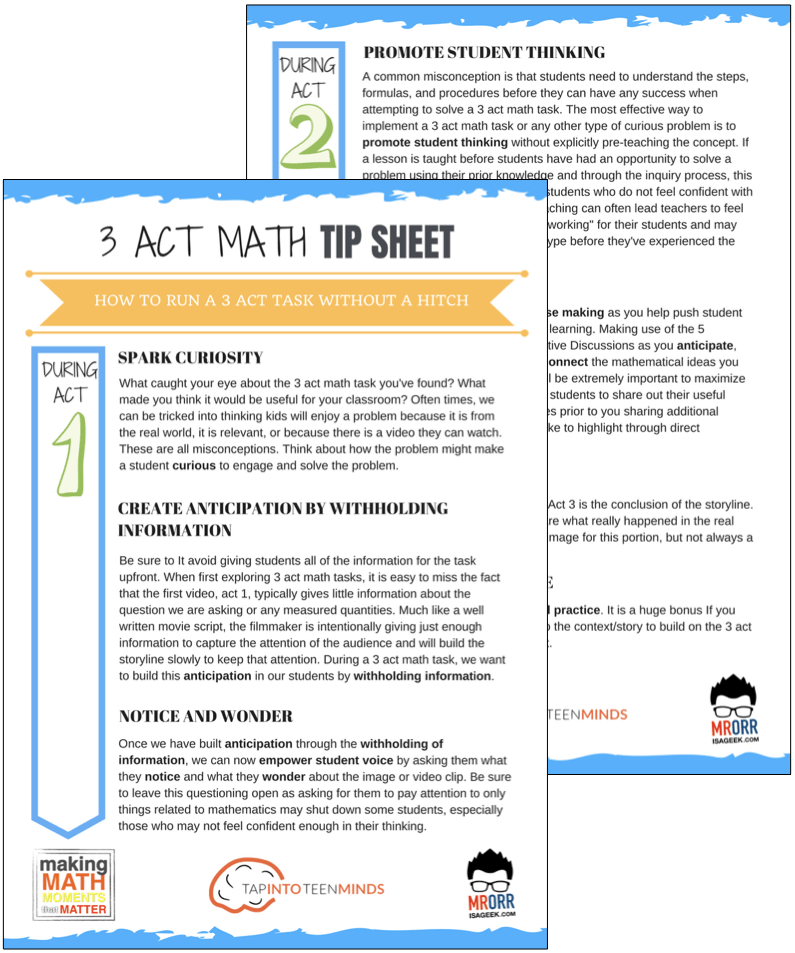
LESSONS TO MAKE MATH MOMENTS
Each lesson consists of:
Each Make Math Moments Problem Based Lesson consists of a Teacher Guide to lead you step-by-step through the planning process to ensure your lesson runs without a hitch!
Each Teacher Guide consists of:
- Intentionality of the lesson;
- A step-by-step walk through of each phase of the lesson;
- Visuals, animations, and videos unpacking big ideas, strategies, and models we intend to emerge during the lesson;
- Sample student approaches to assist in anticipating what your students might do;
- Resources and downloads including Keynote, Powerpoint, Media Files, and Teacher Guide printable PDF; and,
- Much more!
Each Make Math Moments Problem Based Lesson begins with a story, visual, video, or other method to Spark Curiosity through context.
Students will often Notice and Wonder before making an estimate to draw them in and invest in the problem.
After student voice has been heard and acknowledged, we will set students off on a Productive Struggle via a prompt related to the Spark context.
These prompts are given each lesson with the following conditions:
- No calculators are to be used; and,
- Students are to focus on how they can convince their math community that their solution is valid.
Students are left to engage in a productive struggle as the facilitator circulates to observe and engage in conversation as a means of assessing formatively.
The facilitator is instructed through the Teacher Guide on what specific strategies and models could be used to make connections and consolidate the learning from the lesson.
Often times, animations and walk through videos are provided in the Teacher Guide to assist with planning and delivering the consolidation.
A review image, video, or animation is provided as a conclusion to the task from the lesson.
While this might feel like a natural ending to the context students have been exploring, it is just the beginning as we look to leverage this context via extensions and additional lessons to dig deeper.
At the end of each lesson, consolidation prompts and/or extensions are crafted for students to purposefully practice and demonstrate their current understanding.
Facilitators are encouraged to collect these consolidation prompts as a means to engage in the assessment process and inform next moves for instruction.
In multi-day units of study, Math Talks are crafted to help build on the thinking from the previous day and build towards the next step in the developmental progression of the concept(s) we are exploring.
Each Math Talk is constructed as a string of related problems that build with intentionality to emerge specific big ideas, strategies, and mathematical models.
Make Math Moments Problem Based Lessons and Day 1 Teacher Guides are openly available for you to leverage and use with your students without becoming a Make Math Moments Academy Member.
Use our OPEN ACCESS multi-day problem based units!
Make Math Moments Problem Based Lessons and Day 1 Teacher Guides are openly available for you to leverage and use with your students without becoming a Make Math Moments Academy Member.
Partitive Division Resulting in a Fraction
Equivalence and Algebraic Substitution
Represent Categorical Data & Explore Mean
Downloadable resources including blackline masters, handouts, printable Tips Sheets, slide shows, and media files do require a Make Math Moments Academy Membership.
ONLINE WORKSHOP REGISTRATION
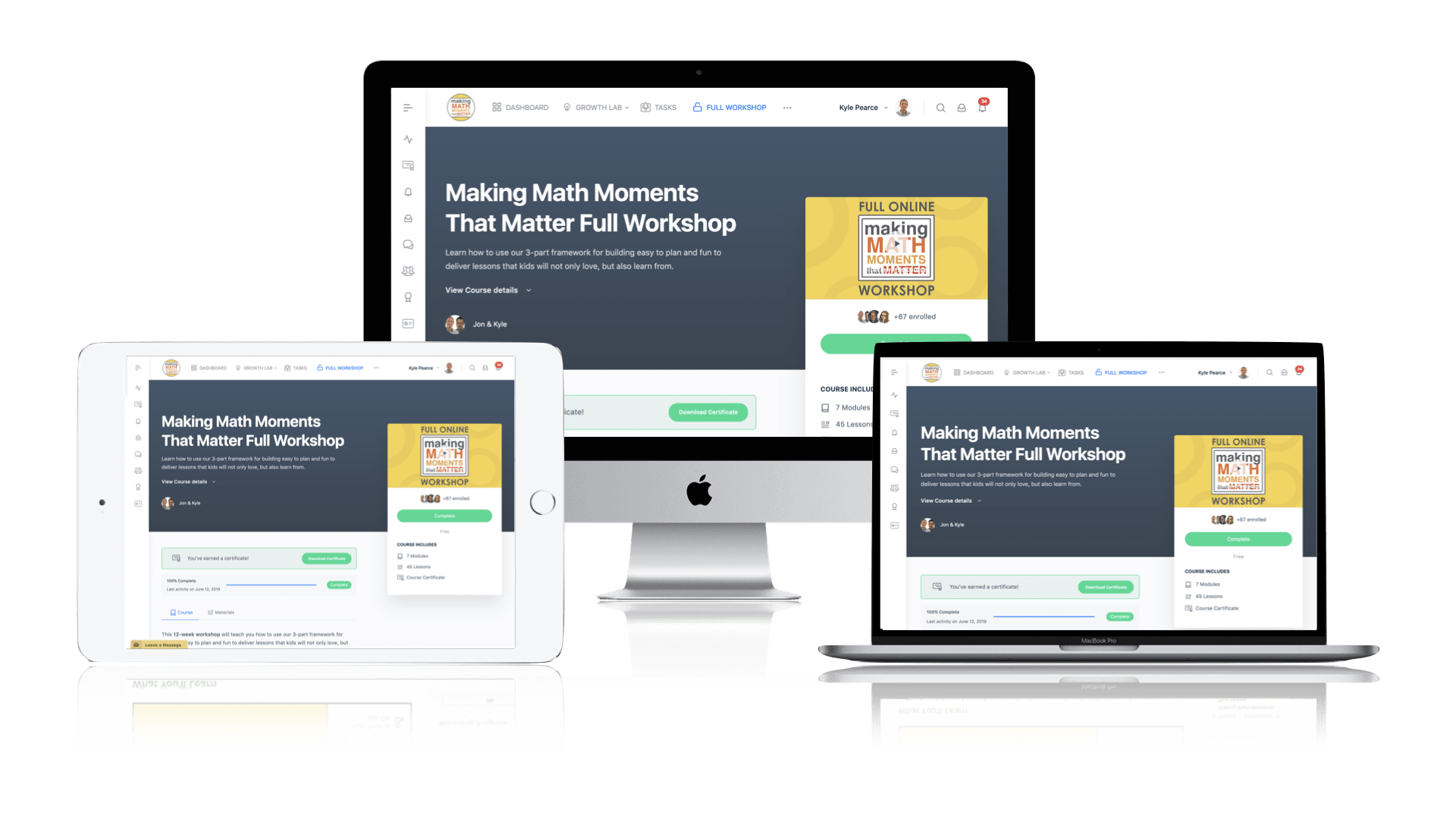
Pedagogically aligned for teachers of K through Grade 12 with content specific examples from Grades 3 through Grade 10.
In our self-paced, 12-week Online Workshop, you'll learn how to craft new and transform your current lessons to Spark Curiosity, Fuel Sense Making, and Ignite Your Teacher Moves to promote resilient problem solvers.
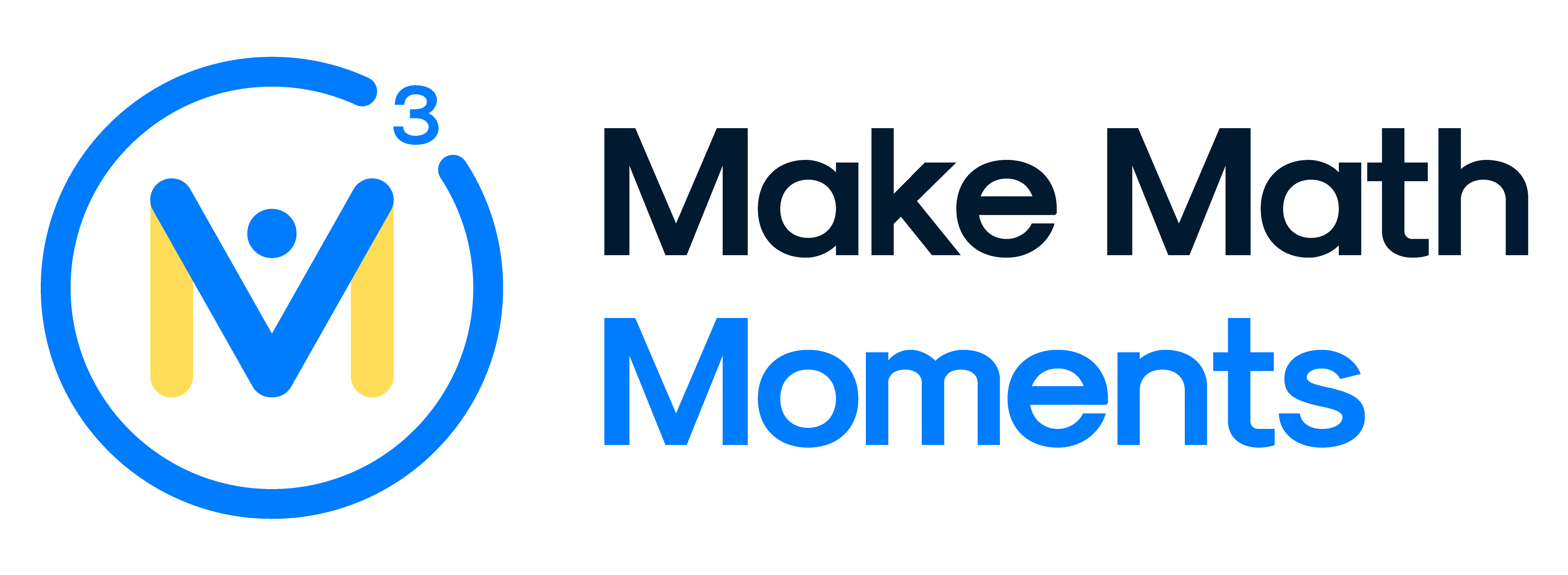



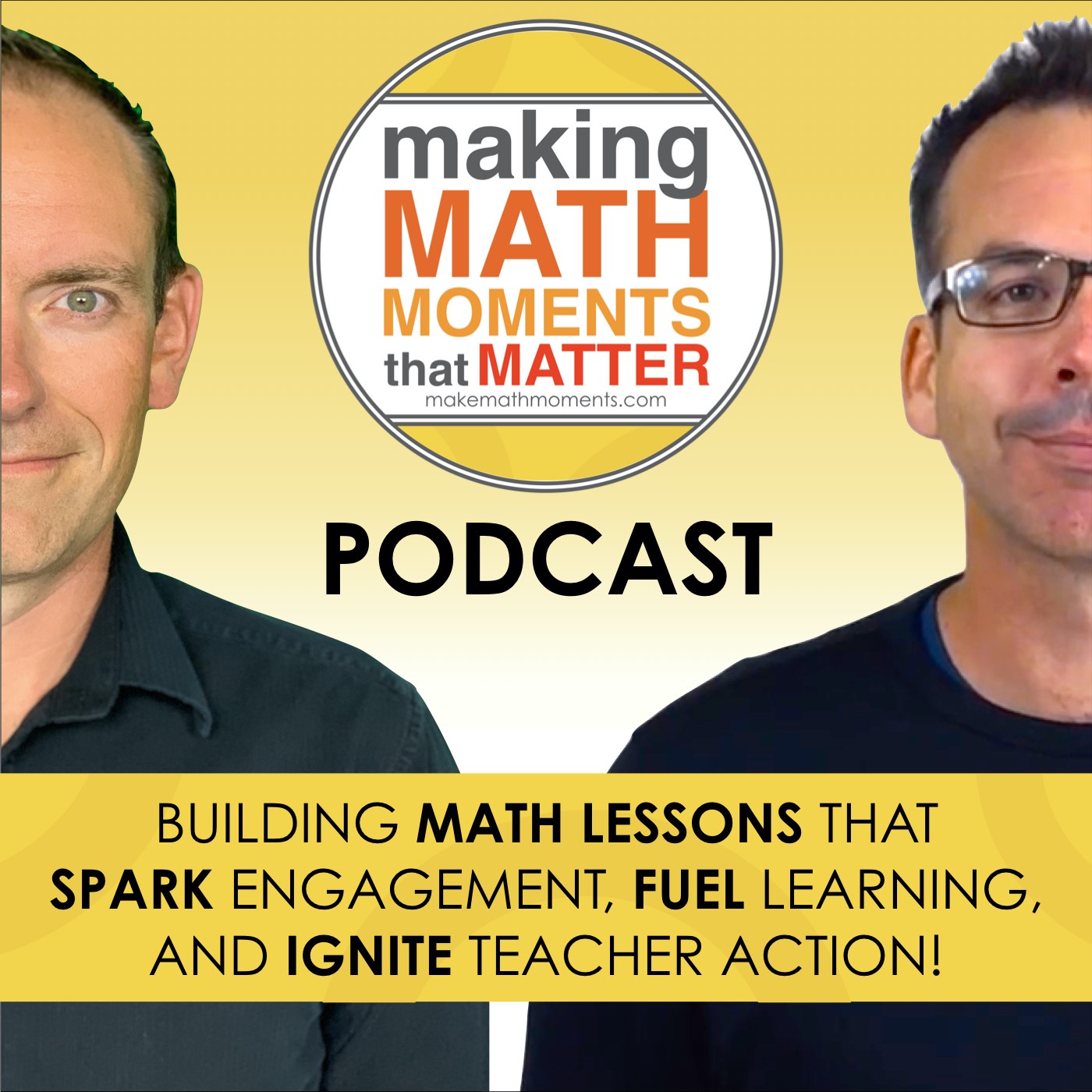
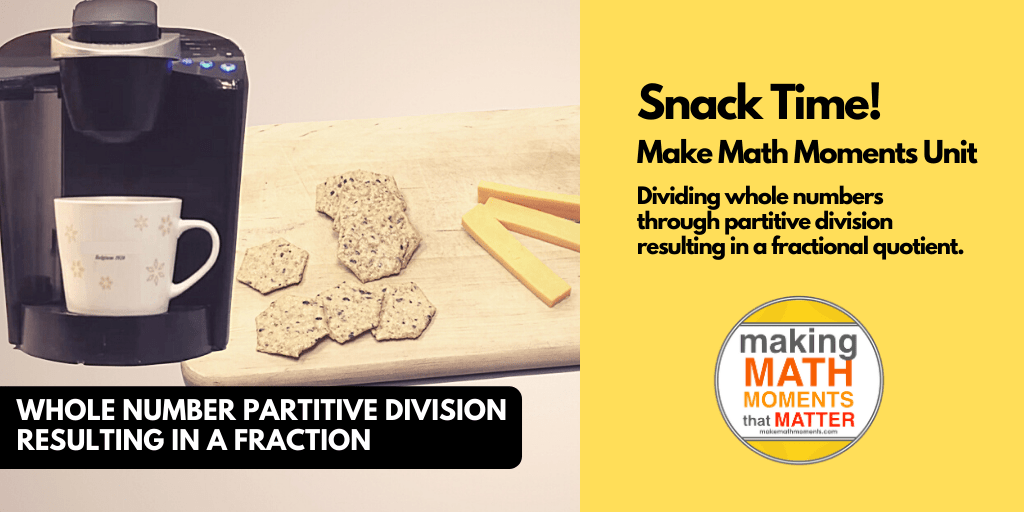

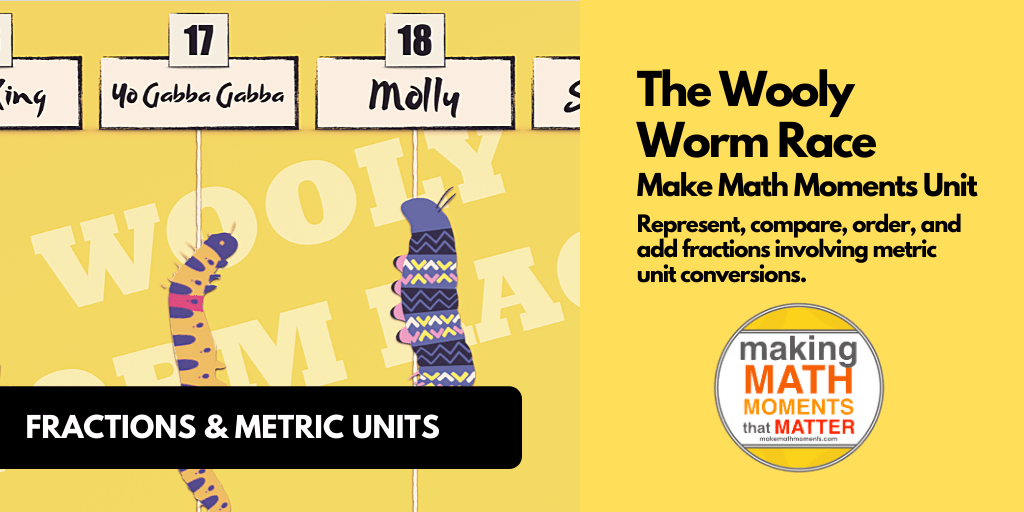
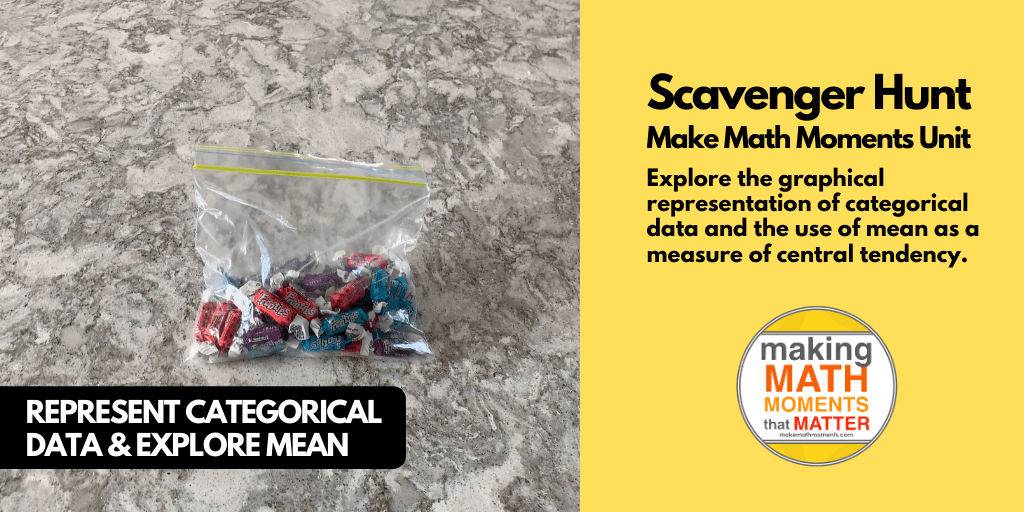

0 Comments